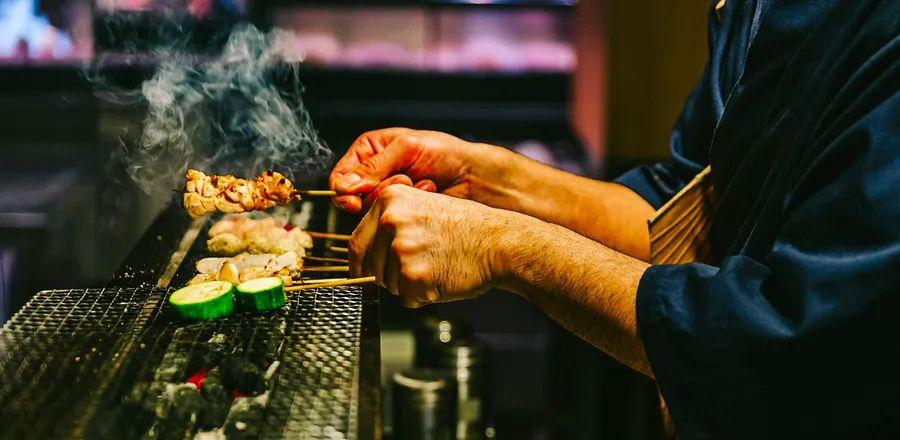8 Must-Try Japanese Street Foods

Tokyo boasts more Michelin stars than almost any other city worldwide, yet some of its—and Japan’s—finest culinary delights are far removed from upscale dining experiences. Discover Japanese street food, which is often enjoyed during festivals, at yatai (casual street food stalls with a few seats for quick bites), at bustling markets like Tsukiji in Tokyo or Nishiki in Kyoto, and along shotengai: long, often pedestrian streets filled with family-run shops.
Many street foods are prepared on grills or roasted, leading to names that include yaki (grilled), which describes the cooking style—think yakitori, takoyaki, yakisoba, and more.
Note: In Japan, it’s generally considered impolite to eat while walking or on the streets. Some vendors at open-air markets encourage patrons to enjoy their food right in front of the stall. If you're unsure, simply ask the shop owner, 'Is it okay?' Here are some popular street foods to seek out on your next trip to Japan.
1. Grilled Chicken Skewers (Yakitori)

Photo by Artit Wongpradu
Various parts of the chicken (tori) are cut into bite-sized pieces, skewered, grilled, and seasoned with shio salt or a sweet tare soy sauce. Popular skewers include momo (thigh), mune (breast), reba (liver), sunagimo (gizzard), tsukune (ground chicken mixed with minced cartilage), and kawa (chicken skin). Upscale yakitori restaurants serve cuts from nearly every part of the chicken.
You can find casual yakitori stalls at shotengai shopping streets or at relaxed tachinomi spots, often located under train tracks or near bustling train stations. High-end establishments typically use smokeless binchotan charcoal. Some yakitori spots also offer yakiton, grilled pork skewers.
Where to enjoy yakitori in Japan:
Sunamachi Ginza is a traditional shotengai shopping arcade located on the east side of Tokyo, featuring three yakitori shops: Takezawa Shouten, Niku no Nakajima, and Okada.
Kyoi Isehiro, just a short stroll from Tokyo Station, has been delighting patrons with yakitori for a century. This shop is renowned for its delicious tsukune.
2. Takoyaki
Small pieces of octopus (tako) are encased in a savory batter and cooked into crispy balls. Takoyaki is generously topped with a rich fruity and savory sauce, finished with a sprinkle of aonori (green seaweed flakes) and katsuobushi (smoked skipjack tuna flakes). While you can find takoyaki all over Japan, Osaka is particularly famous for this dish. A highlight of the experience is watching the chefs skillfully prepare the takoyaki using just two skewers.
Where to find takoyaki in Japan:
Gindaco is a well-known chain with locations all over the country.
In Osaka, Wanaka provides a diverse selection of octopus balls, including a sampler platter featuring four different styles of takoyaki.
3. Ramen
In Fukuoka, the local specialty known as hakata ramen refers to tonkotsu ramen, famous for its rich and flavorful broth made from collagen-rich pork bones. Hakata ramen typically features thin, skinny noodles. Common toppings include cha shu pork slices, pickled red ginger, wood-ear mushrooms, and green onions.
Where to enjoy ramen in Japan:
Fukuoka boasts a vibrant yatai scene that comes alive at night, featuring around 100 food stalls. The Nakasu Island area is a delightful destination; ramen yatai line the river, offering a scenic and memorable experience for slurping noodles.
4. Dango

Moyes
Dango consists of bite-sized balls made from mochiko rice flour, skewered and adorned with toppings like mitarashi (sweet glaze), azuki (sweet red bean paste), or crushed edamame known as zunda. The mitarashi sauce is a sweet and salty blend, typically made from soy sauce and brown sugar, akin to salted caramel. During spring, hanami dango features three colored balls—pink, white, and green—symbolizing cherry blossoms, snow, and the fresh greenery of spring. In autumn, the white mochi tsukimi dango resemble the full moon of the harvest season.
Where to enjoy dango in Japan:
Oiwake Dango Honpo in Shinjuku offers a delightful variety of dango, featuring over a dozen styles, including a nutty black sesame option and a savory shichimi version coated in seven spices and soy sauce, grilled and wrapped in seaweed.
5. Yaki imo
Sweet potatoes (imo) roasted to perfection turn into naturally sweet desserts. Many supermarkets have small in-house roasters selling yaki imo to customers. During winter, trucks wander the streets peddling roasted sweet potatoes, accompanied by cheerful tunes similar to ice cream trucks in the U.S. Yaki imo are delightful when served hot but can also be savored after cooling—skin and all.
Where to find yaki imo in Japan:
Sweet potatoes are slowly roasted in a large earthen pot (tsubo) for up to two hours at Ginza Tsuboyaki Imo, yielding tender, exceptionally sweet potatoes.
Imoyasu in Asakusa serves yaki imo alongside daigaku imo, which are bite-sized fried sweet potatoes drizzled with syrup and sprinkled with black sesame seeds.
6. Yakisoba
Often found at festivals, yakisoba (stir-fried noodles) is a beloved street food. This dish features noodles stir-fried in a Worcestershire-style sauce with cabbage, topped with bright red pickled ginger and a sprinkle of aonori seaweed flakes, rich in oceanic flavor. Yakisoba can also include pork, squid, or a fried egg on top. Note that the noodles resemble ramen, not soba, as suggested by the name; there's also a heartier version made with udon noodles called yakiudon. At restaurants, yakisoba is a popular choice where diners gather around a hot iron plate to cook their own meals, similar to okonomiyaki and monjayaki.
Where to find yakisoba in Japan:
Yakisoba is a beloved local specialty in Fujimiya (Shizuoka Prefecture), Ishinomaki (Miyagi Prefecture), and Oota (Gunma Prefecture), with numerous restaurants offering this dish in each city.
7. Imagawayaki and Taiyaki

VTT Studio
To prepare Imagawayaki and Taiyaki (handheld cakes filled with sweet azuki beans), a pancake-like batter is poured into a heated iron mold and filled with sweet red bean paste. These treats can be round—known as Imagawayaki, Taikoyaki, or Obanyaki—or shaped like a Tai sea bream, referred to as Taiyaki. While the classic filling is sweet red or white bean paste, variations may include sweet custard or other unique fillings created by the shop. Keep an eye out for stalls specializing in Imagawayaki in depachika, the food floors of department stores.
Where to enjoy Imagawayaki or Taiyaki in Japan:
At the depachika in Shinjuku Takashimaya department store, patrons can observe the preparation of round Imagawayaki cakes at Gozasoro. Choose aka an for red bean paste or shiro an for white bean paste.
Yanagiya has been delighting customers with taiyaki since 1916. This quaint shop is nestled on Ningyocho Amazake Yokocho street in Tokyo's historic district.
8. Oden
To prepare oden—a hearty stew featuring fish cakes—fried, grilled, and steamed fish cakes are simmered in a flavorful broth alongside tender daikon, fried tofu, boiled eggs, gelatinous konnyaku, and kombu kelp. A dash of karashi mustard adds a spicy kick to the hot pot, similar to wasabi. The ingredients for oden vary by region, with lighter broth in Kyoto, miso in Nagoya, and a darker soup in Tokyo.
Where to find oden in Japan:
The Sunamachi Ginza shotengai in eastern Tokyo features several places where visitors can buy food and enjoy it right outside or beside the shop. Masuei Kamabokoten is renowned for its selection of handmade fish cakes filled with seafood and vegetables, including squid, burdock root, and shrimp.
In Kanazawa, located by the Sea of Japan, the local version of oden is famous for including an akamaki red-and-white spiral fish cake, baigai whelks, and kanimen crab shells filled with crab meat. Ippukuya offers a vibrant assortment and is a must-visit spot in the bustling Omicho Market in Kanazawa.

1

2

3

4

5
Evaluation :
5/5